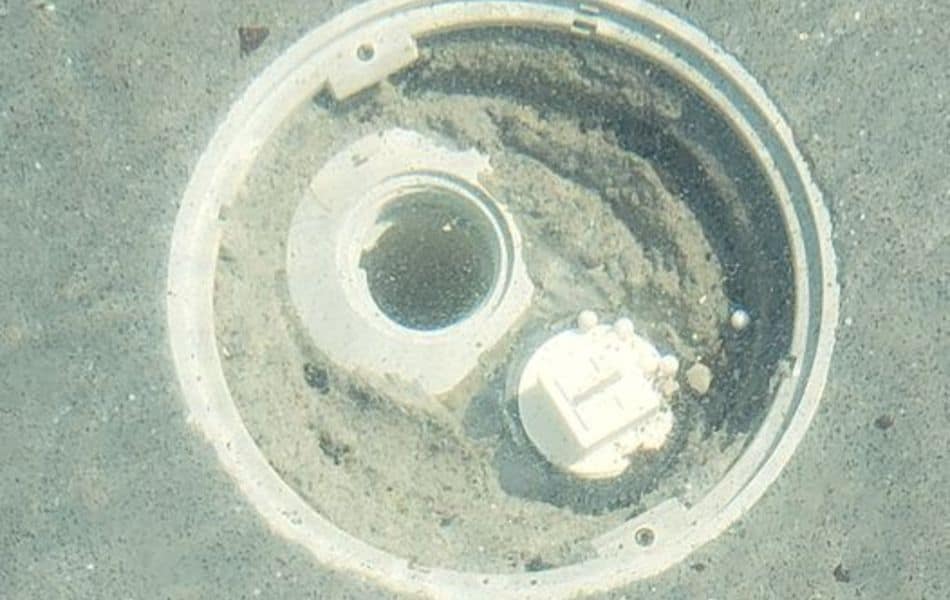Have you just purchased a home with an inground pool or had a brand-new pool constructed? Now you are wondering what all this plumbing is and what it does! You’ve come to the right place, let’s help you identify the plug or plugs at the bottom of your pool.
The plug at the bottom of your pool will be a hydrostatic relief valve or a winterizing wing nut rubber plug. Both of these are extremely important for the longevity and safety of your swimming pool. The hydrostatic relief valve allows groundwater to push up into your pool water to keep the pressure under your pool shell from lifting your pool out of the ground. A winterizing wing nut seals off plumbing like your return lines, drains, and skimmers to keep water out of your pipes during the winter months.
I’m going to discuss more details about the hydrostatic valve and plug so you have more knowledge at your fingertips as a pool owner.
The Drains, Plugs, and Valves in the deepest part of your pool
The lowest point of your pool for inground pool owners will be where the pool contractors have placed your main drain. For above-ground pool owners, this should be right in the center of your pool if you don’t have a slope.
The top part will be your main drain grate which houses the main drain basket. When you remove the top of your main drain grate you will most likely discover a hydrostatic valve and your main drain which may be plugged.
The Main Drain pulls water from the deepest part of your pool into your skimmer basket or more likely directly into your pump. This is an important part of your pool circulation system. If it is plugged by previous owners, it may have been done because it is clogged, damaged, or winterized. If you are unsure, you could remove the plug and troubleshoot the main drain to see if it is working. If it’s because it was winterized then you’ll want to follow the correct processing of opening that main drain back up for the swimming season.
The valve that is inside the basket will be your hydrostatic relief valve which is extremely important and I’ll dive into that in the next section below.
What is the Hydrostatic Relief Valve?
The Hydrostatic Valve allows groundwater to push up into your swimming pool main drain basket. Allowing the water to come into your pool relieves the pressure from below your pool shell. Which keeps your shell from being pushed out of the ground. I deep dive into hydrostatic pressure and more about the relief valve in this article.
Why do I need a Hydrostatic Valve?
The way that hydrostatic pressure works is that the water inside your pool is pushing down on the walls and floor of your pool. On the flip side, your groundwater is pushing up from underneath your pool shell as well. When your pool is full of water, the ground pressure isn’t enough to push the pool out of place but it’s still a good idea to allow your hydrostatic relief valve to relieve some of that pressure.
If your pool shell becomes empty, this is really when that hydrostatic valve comes in handy helping to keep the pressure from pushing your empty shell out of the ground. That isn’t always enough, so I don’t recommend completely emptying your pool of water for long periods of time.
This is why you need a hydrostatic relief valve, it keeps your pool shell exactly where it’s supposed to be. Thank you science!
I have personally never had a pool shell come out of the ground but my dad has had to both demolish and reset pools that have popped out. None that he has ever built though. These are typically older pools that have seen many different owners and some of them did not research or take care of their pools over long periods of time.
What size is the Hydrostatic Valve?
Typically the hydrostatic relief valve is going to be 40mm – 50mm in size. If you are wanting to replace your hydrostatic relief valve you are going to need a tool to do so. It would be best to figure out what size your valve is so you can purchase or rent the appropriate-sized hydrostatic installation and removal tool. I wrote up a helpful article about removing and installing a new hydrostatic relief valve for pool owners.
What is Winterizing Pool Plugs?
So after lifting up your main drain grate you discovered a Wingnut Winterizing Pool Plug. This is completely normal and useful for winterizing pools or closing off drains and pool lines.
The plug creates a seal keeping water from entering the line.
These winterizing plugs you would need for your main drain pipe are usually 1 ½’ or 2’ in size. If you are looking to replace the plug but don’t know the exact size you need for your main drain there are some universal pool plugs available.
Can I remove the Hydrostatic Valve or Winterizing Plugs?
Yes, you can remove both the Hydrostatic relief valve and winterizing plugs. But you should know what your plan is for replacing the valve or opening up sealed-off lines and drains.
You don’t want to completely remove the hydrostatic valve. You can change the valve which is usually required every 5-7 years as the rings on the valve will begin to leak over time.
You can remove the wing nut winterizing plugs but you should read my guide on how to open your pool up for the summer before removing the plugs for the season.
Why is my main drain plugged?
If you bought your pool from a previous owner, it might be best to ask why they chose to plug the main drain. It could have been out of laziness, serious damage, or possibly just a simple clog in the pipes.
If you can’t ascertain why the plug has been used on your main drain or any of your lines, it would be smart to do some troubleshooting on the drain. It could have just been a clog that the previous owner didn’t want to deal with. Or you could be looking at a damaged pipe that would cause you some headaches if you were to open the main drain without repairing it first.
When winterizing your pool, you’ll end up sealing the main drain off with the wingnut plug after the water has been cleared from the pipe. If this is the reason for the plug, then you can be confident in removing the plug and opening up your pool as recommended above.
If it is possible to unseal your main drain to get it working again, I do personally recommend it. The main drain is very important to pool circulation and keeping a healthy and clean pool throughout the season.
Before you begin adjusting or removing any plugs or valves at the bottom of your pool you’ll want to check your pool documentation, inspect your plumbing, contact the previous owner, or consult a professional pool company. Removing an important part of the pool system can be extremely costly if it causes an issue. I hope this article was helpful in identifying what the plug at the bottom of your pool is.

